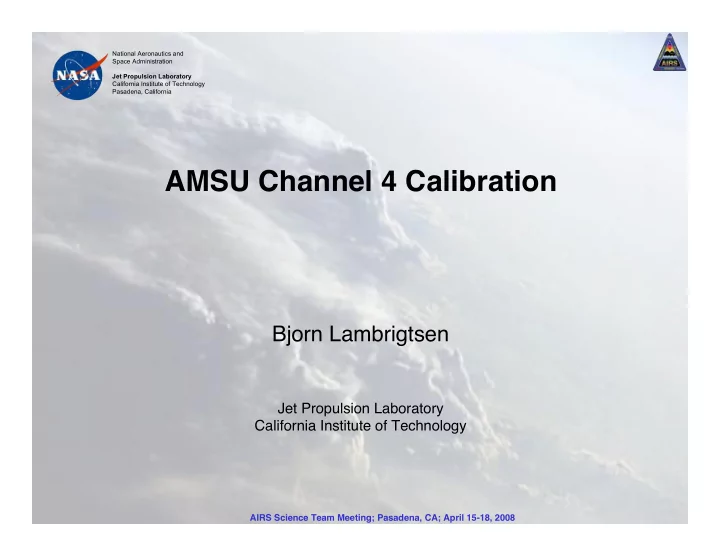

National Aeronautics and Space Administration Jet Propulsion Laboratory California Institute of Technology Pasadena, California AMSU Channel 4 Calibration Bjorn Lambrigtsen Jet Propulsion Laboratory California Institute of Technology AIRS Science Team Meeting; Pasadena, CA; April 15-18, 2008
National Aeronautics and From Nov. 29 NetMeeting: Space Administration Jet Propulsion Laboratory Ch. 4 Radiometric Noise Is Increasing California Institute of Technology Pasadena, California AIRS Science Team Meeting; Pasadena, CA; April 15-18, 2008
National Aeronautics and From Nov. 29 NetMeeting: Space Administration Jet Propulsion Laboratory Ch. 4 Gain Is Decreasing California Institute of Technology Pasadena, California AIRS Science Team Meeting; Pasadena, CA; April 15-18, 2008
National Aeronautics and From Nov. 29 NetMeeting: Space Administration Jet Propulsion Laboratory Strong orbital signal in both WC and CC California Institute of Technology Pasadena, California Tb image visual inspection suggests non-random behavior, but histogram analysis of calcounts indicates random (Gaussian) noise AIRS Science Team Meeting; Pasadena, CA; April 15-18, 2008
National Aeronautics and From Nov. 29 NetMeeting: Space Administration Jet Propulsion Laboratory Variation “predicted” by 3 instrument T � s California Institute of Technology Pasadena, California AIRS Science Team Meeting; Pasadena, CA; April 15-18, 2008
National Aeronautics and From Nov. 29 NetMeeting: Space Administration Jet Propulsion Laboratory Regression fit of cal. coefficients California Institute of Technology Pasadena, California 6 AIRS Science Team Meeting; Pasadena, CA; April 15-18, 2008
National Aeronautics and Space Administration Next step: Consult with manufacturer Jet Propulsion Laboratory California Institute of Technology Pasadena, California • NGES (formerly Aerojet) made some surprising analyses: – Noise increase affects Warm-cal only Cold-cal and scene counts are nominal! – • NGES proposed explanation: Ch. 4 Mixer/IF-amp is likely at fault – – Uses diodes in balanced design – If one of 2 diodes is degrading, the following would happen: Mixer becomes unbalanced • • Gain goes down LO isolation/rejection goes down • • LO leaks through & is reflected from cal-target (but does not affect scene counts) • This would look like noise in warm-cal only – In contrast, IF low-pass filter failure would affect all counts If this is correct, a recovery is possible • – Warm-cal is only used to determine linear gain – There are other methods that can be used instead • NGES tried to develop “recovery” algorithm - Unsuccessful • JPL also tried: See next slides 7 AIRS Science Team Meeting; Pasadena, CA; April 15-18, 2008
National Aeronautics and Space Administration Recover Channel 4? Jet Propulsion Laboratory California Institute of Technology Pasadena, California Alternative calibration algorithm considered by JPL: • – Gain determined by regression against instrument temperatures – Method developed & tested by Thompson, Rogers & Davis “Temperature Compensation of Total Power Radiometers”, IEEE Trans. • Microwave Theory Tech ., 51 , 2073-2078 (2003) This will work if • – Radiometer (receiver) is still linear – Scene observations (Earth, space) are nominal 8 AIRS Science Team Meeting; Pasadena, CA; April 15-18, 2008
National Aeronautics and Space Administration Normal channel (#3): Counts vs. T a Jet Propulsion Laboratory California Institute of Technology Pasadena, California January 1, 2003 March 19, 2008 475 c 490 c � Counts � T a is linear function of counts: � Equivalent � � T a = � N/gain 38 K 37 K � T a � 9 AIRS Science Team Meeting; Pasadena, CA; April 15-18, 2008
National Aeronautics and Space Administration However… Jet Propulsion Laboratory California Institute of Technology Pasadena, California • But, alas – Assumptions do not hold • Scene observations are also affected by hardware failure • Radiometer output is declining towards zero 10 AIRS Science Team Meeting; Pasadena, CA; April 15-18, 2008
National Aeronautics and Space Administration Bad channel (#4): Counts vs. T a Jet Propulsion Laboratory California Institute of Technology Pasadena, California January 1, 2003 March 19, 2008 250 c 220 c If hypothesis holds of bad warm-cal � Counts � good receiver then “scene counts” should remain good However: not so Therefore: Can � t apply “good gain” 42 K 13 K � T a � 11 AIRS Science Team Meeting; Pasadena, CA; April 15-18, 2008
National Aeronautics and Space Administration One orbit: 2003 vs. 2008; Ch.3 vs. Ch.4 Jet Propulsion Laboratory California Institute of Technology Pasadena, California Ch. 4 Ch. 3 2003.01.01.001-017 Note drastic reduction in channel 4 output! Ch. 4 Ch. 3 2008.03.19.001-017 The dynamic range of Ch. 4 has gone down by an order of magnitude AIRS Science Team Meeting; Pasadena, CA; April 15-18, 2008
National Aeronautics and Space Administration Conclusions Jet Propulsion Laboratory California Institute of Technology Pasadena, California • Channel 4 receiver output is both noisy & declining • � (Warm-cal - Cold-cal) is down by an order of magnitude 3587 ± 2.9 in 2003 <-- High output, low noise 409 ± 62 in 2008 <-- Low output, high noise It is highly unlikely that recovery is possible • • It looks like Channel 4 is dying The S/W remedy is likely to remain the best solution 13 AIRS Science Team Meeting; Pasadena, CA; April 15-18, 2008
Recommend
More recommend